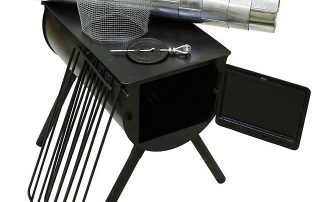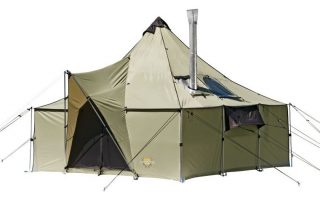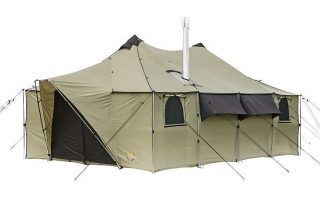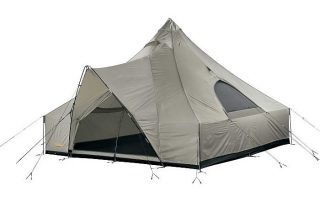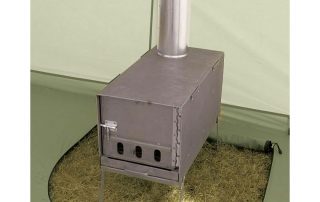Outfitter tents, also known as “wall tents” are, in some ways, the “true” Montana tent. Step out into the woods during hunting season in Montana and you’ll see outfitter tents just about everywhere.
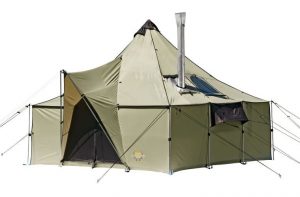
A Cabela’s Outfitter Tent. Designed for cold weather camping and when a “base camp” is needed. More info at Cabela’s.
And the reason for this is very simple. Outfitter tents are exceptionally roomy. More importantly, though, these tents allow for use of a stove to heat the tents interior. The ability to heat these tents is of no small importance, in Montana or other northern climates during late fall and even mid-winter. Hunters and others who spend extended time in the backcountry during cold weather need a heated tent. And only the outfitter tents allows for interior heating.
Outfitter tents are, by their very design, big, bulky and heavy. These tents are simply too big and too heavy for a human to pack in deep into remote areas. Instead, most outfitter tents are bought into the backcountry by horse, mule or 4×4.
Outfitter tents also aren’t the easiest of tents to setup. Numerous poles and guy wires are required to properly set up the tent. As such, this is not the type of tent you want to move frequently.
Due to their weight, bulk and time required to setup the tent, outfitter tents are almost exclusively used as a “base camp” tent. Thus, hunters set up these tents in remote areas and use them as their “home away from home.”
Benefits of an Outfitter Tent
Size
Outfitter tents are available in a wide variety of sizes. And uniquely among most tents, many can have additions attached to them. As such, these tents are superb for large groups—one reason Montana and other mountain hunting guides use these tents.
Interior Height
All outfitter tents—whether small or large—have a peak interior height that allows a person to stand fully upright, and usually with a bit of room to spare. Unlike dome tents, the walls of outfitter tents are nearly vertical. This greatly increases comfort and versatility in the tents interior.
Heat
There are many things to like about an outfitter tent, but I think the primary feature most people like the most is the ability to heat the tents interior. The ability to heat the tents interior to a comfortable temperature—even during the coldest of nights—is a huge selling point of these tents. As such, outfitter tents really are the perfect tent for long-term camping in cold weather.
Durability
Most outfitter tents have thick tent walls. Moreover, aircraft aluminum tent poles are used for the tents frame. The combination of thick tent walls and strong poles make these tents very durable. Provided the tent is properly staked out during windy weather, there’s little concern about these tents falling over or ripping apart—even during the strongest of storms.
So Who Wants an Outfitter Tent?
Outfitter tents are very specialized tents. Their primary function is to provide heated shelter during cold weather in backcountry areas. Thus, the people who generally want and use an outfitter tent include:
Hunting Guides
Need a “home away from home” on hunting trips for their clients
Individual and Group Hunting Parties
These are popular tents by hunters who go out either individually or in a small group, and then spend weeks camped out.
Long Term Winter Camping
People who, for whatever reason, find themselves camping out for extended periods of time in the winter will also appreciate the size, comfort and heat these tents provide.
Who Isn’t an Outfitter Tent For?
Backpackers
This should be obvious, but these tents are too heavy and bulky for any kind of backpacking.
Car Campers
These tents simply take too much time to setup and take down. Unless you’ll be car camping in “one spot” for a while, it makes little sense to buy an outfitter tent.
Summer Camping
Most outfitter tents have thick tent walls with limited ventilation. This design feature makes them great for winter, as it helps hold in heat. But conversely, it limits air movement during the summer. While these tents can still work for extended summer camping, their use is more limited to “cooler climates” such as in the high mountains or Alaska. Hot or humid weather and outfitter tents don’t mix well.
Essential Accessories for Outfitter Tents
Due to their large size and design, there’s endless amounts of accessories for these tents. That said, there’s two accessories that anyone buying an outfitter tent absolutely should buy at the time of tent purchase.
Stove – Outfitter tents are meant for cold weather and are designed for interior heat. As such, plan on purchasing a stove at the time you buy the tent so as to take advantage of the tent’s purpose and design.
Roof Protector – A roof protector protects the tents roof from hot sparks caused by burning wood in the stove. Inevitably, sparks find their way up the chimney of the wood burning stove. The roof protector is a barrier that prevents those hot sparks from landing on the tents roof and burning a hole in fabric.
Where to Buy
Most people shopping for an outfitter tent begin—and end—their search at the only places that really sells them—Cabela’s.
Cabela’s is about the only online retailer that has a large selection of these tents and also allows for customer customizations on some tent models.


